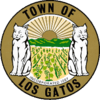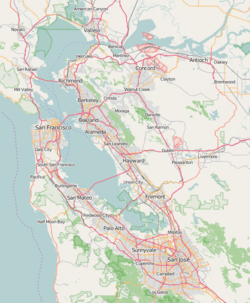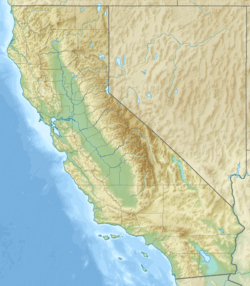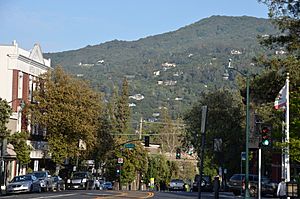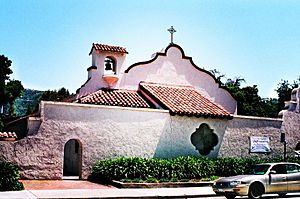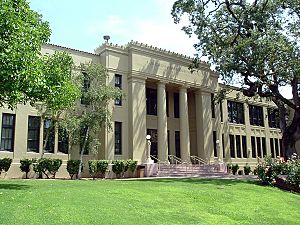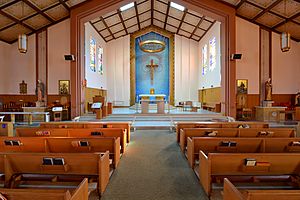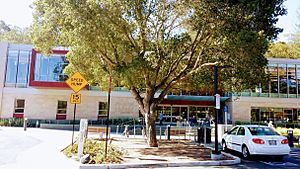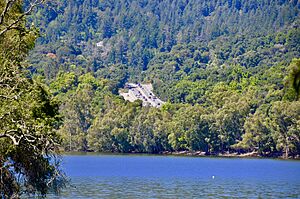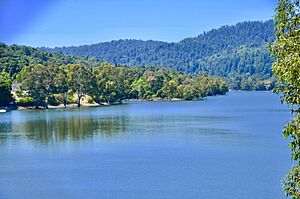Los Gatos, California facts for kids
Quick facts for kids
Los Gatos, California
|
|||
|---|---|---|---|
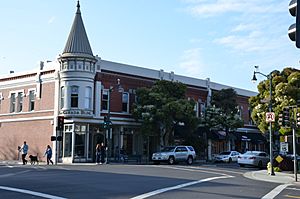
La Cañada Building in April 2016
|
|||
|
|||
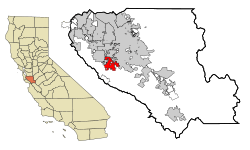
Location in Santa Clara County and the state of California
|
|||
| Country | United States | ||
| State | California | ||
| County | Santa Clara | ||
| Incorporated | August 10, 1887 | ||
| Named for | Rancho Rinconada de Los Gatos | ||
| Area | |||
| • Total | 11.44 sq mi (29.64 km2) | ||
| • Land | 11.36 sq mi (29.43 km2) | ||
| • Water | 0.08 sq mi (0.21 km2) 0.71% | ||
| Elevation | 344 ft (105 m) | ||
| Population
(2020)
|
|||
| • Total | 33,529 | ||
| • Density | 3,026.08/sq mi (1,026.95/km2) | ||
| Time zone | UTC−8 (Pacific) | ||
| • Summer (DST) | UTC−7 (PDT) | ||
| ZIP Codes |
95030–95033
|
||
| Area codes | 408/669 | ||
| FIPS code | 06-44112 | ||
| GNIS feature IDs | 1659017, 2412917 | ||
Los Gatos (US: /loʊs ˈɡɑːtoʊs, lɔːs -/; Spanish: [los ˈɣatos]; Spanish for 'The Cats') is a town in Santa Clara County, California, United States. It is home to about 33,529 people, based on the 2020 census. Los Gatos is located in the San Francisco Bay Area, just southwest of San Jose. It sits in the foothills of the Santa Cruz Mountains.
Los Gatos is part of Silicon Valley, a famous area for high technology companies. Netflix, the well-known streaming service, has its main office in Los Gatos.
Contents
- What's in a Name? The Meaning of Los Gatos
- A Look Back: The History of Los Gatos
- Where is Los Gatos? Geography and Environment
- Economy: Companies and Jobs in Los Gatos
- People of Los Gatos: Demographics
- Getting Around: Transportation in Los Gatos
- Learning in Los Gatos: Education
- Exploring Los Gatos: Museums and Outdoor Fun
- Global Connections: Sister Cities
- Famous Faces: Notable People from Los Gatos
- See also
What's in a Name? The Meaning of Los Gatos
The name Los Gatos comes from Spanish and means "The Cats". This name comes from a land grant in 1839 called La Rinconada de Los Gatos. This means "The Corner of the Cats".
The "cats" refer to wild animals like cougars (mountain lions) and bobcats. These animals naturally live in the foothills where the town is located.
A Look Back: The History of Los Gatos
Early Days and First Settlers
The first people to live in the Los Gatos area were the Ohlone Native Americans. When the first European settlers arrived, around 5,000 native people lived in the Valley. The early settlers and native people had a good relationship.
The town started in the mid-1850s. This was when James Alexander Forbes built a flour mill called Forbes Mill along Los Gatos Creek. Part of the old mill, a two-story stone building, is still standing today.
Growth and Development of the Town
The settlement was first named after the mill. But later, its name changed to Los Gatos, after the Spanish land grant. The town officially became a town in 1887. It was important for the logging industry in the Santa Cruz Mountains until the late 1800s.
Los Gatos became a key stopping point on the way between San Jose and Santa Cruz. This was because of the Los Gatos Turnpike road. By 1868, the town had a mill, a blacksmith shop, a stagecoach stop, a lumber yard, a school, a hotel, and a post office.
Los Gatos as an Arts Community
In the early 1900s, Los Gatos became a farming town. Farmers grew apricots, grapes, and prunes. By the 1920s, Los Gatos was known as an arts community. Many painters, musicians, writers, and actors came to live there.
Famous people like violinist Yehudi Menuhin lived here as a boy. Actresses Joan Fontaine and Olivia de Havilland went to Los Gatos High School. Author John Steinbeck wrote The Grapes of Wrath in the area.
Historic Buildings and Architecture
Downtown Los Gatos has kept many of its old Victorian-style homes and shops. The Forbes Mill annex, built in 1880, is a notable building. Los Gatos High School, from the 1920s, is also important. The Old Town Shopping Center used to be the University Avenue School.
Some brick buildings in downtown Los Gatos were damaged in the 1989 Loma Prieta earthquake. However, the area was quickly rebuilt and looks great today.
Trains and Transportation History
Trains were very important for Los Gatos's growth a long time ago. The South Pacific Coast Railroad used to stop in Los Gatos. This line connected Alameda (and San Francisco by ferry) to Santa Cruz in the late 1800s.
The last passenger train to Santa Cruz left Los Gatos in 1940. Today, Los Gatos does not have regular passenger train service. The old train station site is now Town Plaza and the post office.
The Oil Boom in Los Gatos
Between 1891 and 1929, about 20 oil wells were drilled near Los Gatos. This started a small oil-drilling boom. Oil was first found in streams and springs in the Santa Cruz Mountains around 1861.
The Moody Gulch oil field was created, but it didn't produce as much oil as hoped. It was closed around 1938. Even though it wasn't a huge success, some oil was used by local people for fuel and road tar.
Where is Los Gatos? Geography and Environment
Los Gatos is located at 37°14′10″N 121°57′42″W / 37.23611°N 121.96167°W. State Route 17 runs through the town from south to north. State Route 85 is roughly the northern edge of the town.
Downtown Los Gatos is around Santa Cruz Avenue and Main Street. It has a charming, older feel. The area around Los Gatos Boulevard, east of Highway 17, is more modern with shopping centers.
Vasona Park, a county park, and Oak Meadow Park are in the middle of town. These parks are home to the popular William "Billy" Jones Wildcat Railroad. The Los Gatos Creek Trail runs alongside Los Gatos Creek. This trail is great for walking, jogging, and biking. It passes by the historic 1854 Forbes Mill.
Los Gatos is surrounded by many mountain bike trails. Cyclists can ride from downtown into the Santa Cruz Mountains. The El Sereno Open Space Preserve and the Sierra Azul Open Space Preserve offer hiking and cycling.
The town covers about 11.2 square miles (29 km2). Most of this area is land, with a small amount of water.
Weather and Climate
Los Gatos has a warm-summer Mediterranean climate. This means it has warm, dry summers and mild, wet winters. It rarely gets very cold or has a hard frost. This climate is good for growing grapes and having vineyards.
The highest temperature ever recorded was 114 °F (46 °C) (46 °C) in June 1961. The lowest was 16 °F (−9 °C) (-9 °C) in December 1990. Los Gatos gets about 27 days a year with temperatures of 90 °F (32 °C) (32 °C) or higher. It only gets about 5 days a year with temperatures of 32 °F (0 °C) (0 °C) or lower.
Rainfall averages about 21.2 inches (54 cm) (53.8 cm) per year. It usually rains on about 59 days each year. Snow is very rare in Los Gatos, even though it sometimes falls in the nearby Santa Cruz Mountains. Los Gatos enjoys about 330 sunny days every year.
| Climate data for Los Gatos, California, 1991–2020 normals, extremes 1893–present | |||||||||||||
|---|---|---|---|---|---|---|---|---|---|---|---|---|---|
| Month | Jan | Feb | Mar | Apr | May | Jun | Jul | Aug | Sep | Oct | Nov | Dec | Year |
| Record high °F (°C) | 81 (27) |
82 (28) |
89 (32) |
96 (36) |
103 (39) |
114 (46) |
113 (45) |
107 (42) |
110 (43) |
103 (39) |
89 (32) |
83 (28) |
114 (46) |
| Mean maximum °F (°C) | 71.9 (22.2) |
73.1 (22.8) |
78.4 (25.8) |
85.7 (29.8) |
90.8 (32.7) |
98.7 (37.1) |
98.5 (36.9) |
98.8 (37.1) |
98.5 (36.9) |
90.0 (32.2) |
81.0 (27.2) |
68.3 (20.2) |
101.9 (38.8) |
| Mean daily maximum °F (°C) | 58.5 (14.7) |
61.9 (16.6) |
66.3 (19.1) |
70.3 (21.3) |
75.5 (24.2) |
81.7 (27.6) |
84.9 (29.4) |
84.5 (29.2) |
82.7 (28.2) |
75.5 (24.2) |
64.6 (18.1) |
57.7 (14.3) |
72.0 (22.2) |
| Daily mean °F (°C) | 49.0 (9.4) |
51.6 (10.9) |
54.7 (12.6) |
57.6 (14.2) |
62.3 (16.8) |
67.1 (19.5) |
70.4 (21.3) |
70.2 (21.2) |
68.0 (20.0) |
62.2 (16.8) |
53.6 (12.0) |
48.4 (9.1) |
59.6 (15.3) |
| Mean daily minimum °F (°C) | 39.5 (4.2) |
41.3 (5.2) |
43.1 (6.2) |
44.9 (7.2) |
49.2 (9.6) |
52.5 (11.4) |
55.9 (13.3) |
55.8 (13.2) |
53.5 (11.9) |
48.9 (9.4) |
42.7 (5.9) |
39.1 (3.9) |
47.2 (8.5) |
| Mean minimum °F (°C) | 35.1 (1.7) |
33.6 (0.9) |
35.9 (2.2) |
36.9 (2.7) |
40.9 (4.9) |
44.1 (6.7) |
48.3 (9.1) |
49.1 (9.5) |
47.0 (8.3) |
44.5 (6.9) |
38.3 (3.5) |
33.1 (0.6) |
30.4 (−0.9) |
| Record low °F (°C) | 18 (−8) |
21 (−6) |
27 (−3) |
30 (−1) |
34 (1) |
35 (2) |
37 (3) |
39 (4) |
38 (3) |
31 (−1) |
22 (−6) |
16 (−9) |
16 (−9) |
| Average precipitation inches (mm) | 5.03 (128) |
4.90 (124) |
3.43 (87) |
1.37 (35) |
0.53 (13) |
0.15 (3.8) |
0.00 (0.00) |
0.03 (0.76) |
0.05 (1.3) |
0.76 (19) |
1.97 (50) |
3.97 (101) |
22.19 (562.86) |
| Average precipitation days (≥ 0.01 in) | 10.1 | 9.3 | 9.0 | 5.5 | 2.3 | 0.7 | 0.0 | 0.2 | 0.4 | 2.7 | 5.7 | 9.7 | 55.6 |
| Source 1: NOAA | |||||||||||||
| Source 2: NWS/XMACIS2 (mean maxima/minima 2006–2020) | |||||||||||||
Economy: Companies and Jobs in Los Gatos
Los Gatos is home to several important companies. Many of these are in the technology sector.
Major Companies Headquartered in Los Gatos
- BrightSign
- Buongiorno
- Cryptic Studios
- Digital Media Academy
- EverSport
- Facilitron
- ImageShack
- Impetus Technologies
- Import.io
- Kyvos Insights
- Netflix
- Par Avion Tea
- Smashwords
- NEON
Top Employers in Los Gatos
The biggest employers in Los Gatos include:
| # | Employer | # of Employees |
|---|---|---|
| 1 | Netflix | 2,524 |
| 2 | El Camino Hospital Los Gatos | 560 |
| 3 | Courtside Tennis Club | 542 |
| 4 | Los Gatos-Saratoga Joint Union High School District | 320 |
| 5 | Safeway | 314 |
| 6 | Los Gatos Union School District | 281 |
| 7 | Vasona Creek Health Care Center | 250 |
| 8 | Terraces of Los Gatos | 228 |
| 9 | Good Samaritan Regional Cancer Center | 200 |
| 10 | Town of Los Gatos | 161 |
People of Los Gatos: Demographics
| Historical population | |||
|---|---|---|---|
| Census | Pop. | %± | |
| 1880 | 555 | — | |
| 1890 | 1,652 | 197.7% | |
| 1900 | 1,915 | 15.9% | |
| 1910 | 2,232 | 16.6% | |
| 1920 | 2,317 | 3.8% | |
| 1930 | 3,168 | 36.7% | |
| 1940 | 3,597 | 13.5% | |
| 1950 | 4,907 | 36.4% | |
| 1960 | 9,036 | 84.1% | |
| 1970 | 22,613 | 150.3% | |
| 1980 | 26,906 | 19.0% | |
| 1990 | 27,357 | 1.7% | |
| 2000 | 28,592 | 4.5% | |
| 2010 | 29,413 | 2.9% | |
| 2020 | 33,529 | 14.0% | |
| U.S. Decennial Census | |||
As of 2022, Los Gatos has about 33,093 people living in 12,855 households. The town's population density is about 2,864.2 inhabitants per square mile (1,105.9/km2).
Most residents are White (71.7%), followed by Asian (17.2%). About 8.2% of the population is Hispanic or Latino.
The average household size is about 2.5 people. The median age in Los Gatos is about 45.6 years old. This means half the people are younger and half are older than this age.
The median income for a household in Los Gatos is high, at $198,117. This shows that many people in Los Gatos have good jobs.
Getting Around: Transportation in Los Gatos
The VTA provides bus service in Los Gatos. This service also covers most of Santa Clara County, including San Jose.
Two Los Gatos Community Buses run to the Winchester Transit Center. The 49 bus goes via Los Gatos Boulevard, and the 48 bus goes via Winchester.
For train travel, the closest station is in Santa Clara. It is served by Caltrain. In Campbell, you can find VTA light rail at the Winchester, Downtown Campbell, and Hamilton stations.
For air travel, the closest international airports are San Jose International Airport (SJC), San Francisco International Airport (SFO), and Oakland International Airport (OAK). These airports serve the entire Bay Area.
Learning in Los Gatos: Education
Public Schools in Los Gatos
- Lakeside Joint School District
- Loma Prieta Joint Union Elementary School District
- Los Gatos-Saratoga Joint Union High School District
- Los Gatos High School
- Los Gatos Union School District
- Raymond J. Fisher Middle School
- Daves Avenue Elementary School
- Louise Van Meter Elementary School
- Blossom Hill Elementary School
- Lexington Elementary School
- Union School District
- Alta Vista Elementary School
- Campbell Union & Campbell High School District
Private Schools in Los Gatos
- Roman Catholic
- St. Mary's School
- Jewish
- Yavneh Day School
- Secular
- Hillbrook School
- Stratford School
- Fusion Academy
Public Libraries in Los Gatos
The Los Gatos Public Library is run by the Town of Los Gatos. It is not part of the Santa Clara County Library system. The library is located at 100 Villa Ave, Los Gatos, CA. Any California resident can get a library card with proper ID.
Exploring Los Gatos: Museums and Outdoor Fun
Museums to Visit
The New Museum (NUMU) used to be called Museums of Los Gatos. It has exhibits and programs about art and history in Los Gatos and the San Francisco Bay Area.
Outdoor Activities for Everyone
Los Gatos offers many outdoor activities. You can enjoy mountain biking, road cycling, trail running, kayaking, and hiking. The Los Gatos Creek Trail is a popular spot. Vasona Lake Park is right in the center of town.
Global Connections: Sister Cities
Los Gatos has five official sister cities:
 Zhonghe District, Taiwan
Zhonghe District, Taiwan Liaoyang, People's Republic of China
Liaoyang, People's Republic of China Listowel, County Kerry, Ireland
Listowel, County Kerry, Ireland Tallinn, Estonia
Tallinn, Estonia Zihuatanejo, Mexico
Zihuatanejo, Mexico
Famous Faces: Notable People from Los Gatos
Actors
- Olivia de Havilland – actress, attended Los Gatos High School
- Aaron Eckhart – actor, grew up in Los Gatos
- Joan Fontaine – actress, attended Los Gatos High School
- Jason Jurman – actor
Artists
- Kari Byron – sculptor and TV personality from MythBusters
- Marshall Merritt – painter
- Gordon Smedt – pop art painter
Athletes and Coaches
- Nick Bawden – NFL player, attended Los Gatos High School
- Kiko Alonso – NFL player, attended Los Gatos High School
- Jared Allen – former NFL player, attended Los Gatos High School
- A. J. Allmendinger – race car driver
- Rob Blake – former Los Angeles Kings player
- Jeff Blauser – former Atlanta Braves shortstop
- Brent Burns – San Jose Sharks player
- Joe Cannon – San Jose Earthquakes player
- Hal Chase – early baseball star
- Megan Cooke – silver medalist rower
- Vincent Damphousse – San Jose Sharks player
- Trent Edwards – former NFL quarterback
- Peggy Fleming – Olympic gold medalist figure skater
- Dany Heatley – former San Jose Sharks player
- Jason Hinkin – pole vaulter
- Tim Hunter – former NHL player and coach
- Joe Kapp – NFL quarterback
- Steven Kwan - MLB player
- Andy Levitre – NFL offensive lineman
- Roger Maltbie – PGA Tour golfer
- Patrick Marleau – San Jose Sharks player
- Steve Mariucci – NFL and NCAA coach
- Ryan Nyquist – bicycle moto-cross rider
- Elliana Pogrebinsky – figure skater
- Mike Ricci – San Jose Sharks player
- Jeremy Roenick – former San Jose Sharks player
- Kyle Shanahan - NFL Head Coach
- Derek Smith – former San Francisco 49ers linebacker
- Joe Thornton – San Jose Sharks player
- Christine Von Saltza – Olympic gold medalist in Swimming, attended Los Gatos High School
- Charlie Wedemeyer – football coach
- Doug Wilson – general manager for San Jose Sharks
- Kevin Youkilis – Major League Baseball player
- Russell Mark Tanner – Volleyball player
- John Ellis – PGA Tour Golfer
Business Leaders
- Jeff George – NASA program director
- Jim Goetz – investor
- Charles Walton – inventor of RFID
- Steve Wozniak – Apple Computer co-founder
- Chuck Robbins – Cisco Systems CEO
Musicians
- Dredg – band formed in Los Gatos
- Casey Hensley – blues singer
- Yehudi Menuhin – violinist
- Trapt – band formed in Los Gatos
- Bassnectar – electronic music producer
- Marco Pitruzzella – drummer
Writers and Journalists
- Neal Cassady – author
- Victor Koman – science fiction writer
- Ross Macdonald – novelist
- Alice MacGowan - author
- Rudy Rucker – author
- Josh Shipp – TV host and author
- John Steinbeck – famous author
- Charles Erskine Scott Wood – author and civil rights advocate
- Sandy Hill – author and mountaineer
Other Notable People
- Rollo Beck – ornithologist
- Mark Bingham and Todd Beamer – passengers on United Airlines Flight 93 on 9/11
- Eric Drew – activist
- Dan Jinks – Film and Television Producer
- David Kinch – chef and restaurateur
- Charles A. Lockwood – World War II naval commander
- Richard Thacker Morris – chairman of sociology department at UCLA
- Kenny Ortega – director and choreographer
- Steve Poizner – former State Insurance Commissioner
- Blessed Miguel Pro – Mexican Jesuit priest
- Tucker Reed – Feminist author
See also
 In Spanish: Los Gatos (California) para niños
In Spanish: Los Gatos (California) para niños



